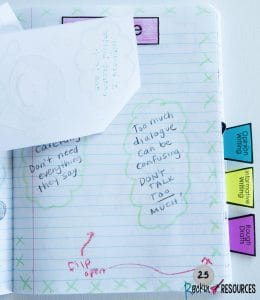Are you looking for ideas to teach students how to write dialogue in a narrative essay? This blog has creative ideas to show your students the right amount of dialogue to use in a story and activities to motivate and educate! These ideas are ideal for any writing curriculum and are a part of a series of mini lessons for writer’s workshop designed for scaffolding through the writing process.
Use the following ideas to teach adding dialogue to a narrative story.
1. TEACH
Start off with a song. I love love love playing the song, You Talk Too Much. You can find it here- My students giggle every time I play it and they look around the room wondering what it has to do with writing! He He:
How should dialogue be used?
Dialogue should be chosen carefully. Readers don’t need to know everything the characters are saying. Too much dialogue can be very confusing.
A. Never say the obvious.
Ex. Joi said, “I was at the park too. There were slides, swings, and monkey bars.”
B. Skip the meet and greet.
Ex. “Hi James, ” he said James replied, “Hello there!”
C. When characters speak, something should be happening and the plot should be progressing. Conflict between characters is a great place to add dialogue, but balance it with action!
Ex. Tim screamed, “You stole the purple pens!” As he marched over to Lucy, she folded her arms.
D. Use dialogue to reveal a character’s personality.
Ex. Lisa criticized, “Did you see that girl’s ugly dress? I would never wear that.”
*** I like this idea from Janet Fitch: Find a section in the story where the characters have a whole conversation, and then cross out the dialogue that is commonplace. Because, as Fitch says, “A line anybody could say is a line nobody should say.” BRILLIANT!!!!!
2. MENTOR TEXT
Mentor Texts show the appropriate amount of dialogue. I am sure you have one of these sitting on your library shelf! They all show great examples of using dialogue in a narrative story! Read the story to your students and point out how the author uses dialogue.
How I Became a Pirate by Melinda Long
I Will Never Not Ever Eat a Tomato by Lauren Child
Quick as a Cricket by Audrey Wood
3. MODEL
Take your class story and find places to add meaningful dialogue. Talk it out with your class. Why would this be a good place to a add dialogue? How can we make it meaningful?
4. TAKING NOTES
Taking notes on how to write dialogue will help students remember the lesson as well as give them a resource to refer back to when writing. This interactive writing notebook page uses speech bubbles to give example of dialogue and flip open to take notes. You may also use MINI WRITING ANCHOR CHARTS to paste in notebooks if you don’t have time for interactive writing notebooks.

5. PRACTICE
Give students a few story prompts and have them work in groups or partners to develop meaningful dialogue between characters. Share with the rest of the group or class. If you are in need of prompts, click PROMPTS for a variety of resources.
6. APPLY
Students should apply their knowledge on writing dialogue by adding meaningful dialogue to their story.
7. SHARE
Share dialogue ideas with partners, groups, or whole group. This will help reluctant writers to think of ideas for their own story and confident writers to think back on their own writing for improvement.
I HOPE YOU FOUND THIS USEFUL AND YOUR STUDENTS ARE USING DIALOGUE IN A WAY THAT WON’T MAKE YOU PULL YOUR HAIR OUT!
Check out my FREE writing masterclass! CLICK HERE
LAST LESSON: WRITING MINI LESSON #19- DEVELOPING CHARACTER TRAITS
NEXT LESSON: WRITING MINI LESSON #21- WRITING THE CONCLUSION OF A NARRATIVE ESSAY!
CLICK HERE FOR THE FULL LIST OF WRITING MINI LESSONS
This lesson is also included in the STEP-BY-STEP WRITING® Programwith mini-lessons designed to scaffold through the writing process. Writing units included are sentence structure, paragraph writing, narrative writing, opinion writing, and informative writing. See what is included in the image below and click on it to learn more about them! You will turn your reluctant writers into ROCKSTAR WRITERS™!
“You are an angel! Not only is this a spectacular resource but my students are constantly engaged. I’ve never used an interactive notebook type resource before and I am sold! The children are learning without realising it and I have never had such success with narrative writing across so many students. I am pleasantly amazed. Looking forward to moving onto the other text types as the year progresses (calendar year in Australia). Thank you so much!” -Mrs. N.






